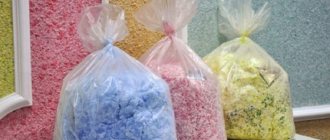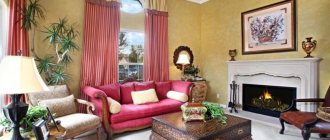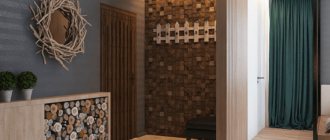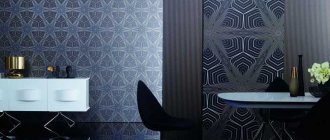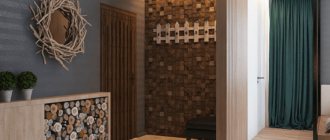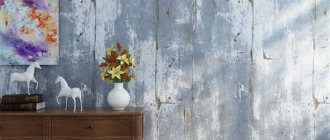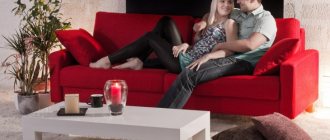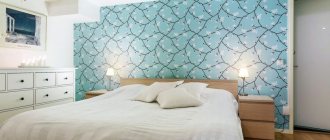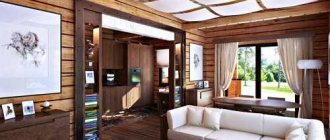Comfort, traditional simplicity of room decoration, along with excellent decorative properties, are provided by bamboo wallpaper in the interior, photos of which are located below. If you want to change the appearance of your home yourself, we advise you to pay attention to this material, which, in addition to excellent external data, is also highly environmentally friendly. Let's look at the advantages, nuances, secrets of installing and operating bamboo wallpaper.
Environmental friendliness is an undeniable argument of bamboo wallpaper.
In their own way, let’s say composition, these wallpapers are divided into two types:
- Made from single pieces of bamboo.
- Made from pressed bamboo fibers.
In both cases, bamboo plates, also called lamellas, are attached to a fabric base or rice paper. The difference between the slats is the thickness. Wallpaper made from solid strips of bamboo has a thickness of 4-20 mm, while wallpaper made from fiber has a thickness of 25-100 mm. In the first case, a bamboo trunk is used for production, which is split into strips. In the second case, bamboo trunks are separated into fibers, plates are pressed from them and cut into strips of the required thickness. Thanks to natural raw materials, bamboo wallpaper is highly environmentally friendly and is considered one of the “cleanest” materials for wall decoration.
Bamboo wallpaper has huge advantages over other types of wall coverings.
Did you know that in nature, bamboo is half liquid. Some peoples inhabiting warm countries use it as a natural filter to obtain water.
First of all, they are able to normalize the humidity of the room. During the production process, the stems of the plant are half dried in the open air. Then it is transferred to a warehouse, where it “ripens” for subsequent production. Thanks to this, wallpaper is able to absorb excess moisture.
The antibacterial properties of bamboo are due to the “bambo kam” element, which prevents the growth of bacteria and fungi. Therefore, it is advisable to paste over not only the walls, but also the ceiling.
The ability to withstand mechanical stress allows you to use bamboo wallpaper indoors and outdoors, after first opening it with varnish, which provides additional protection from the external environment.
Insulating properties make it possible to save heat energy and protect the room from unnecessary noise.
Easy to use - all you need is a flat surface, no additional processing. Even without having certain skills, you can easily cope with the task. Versatility - it is not necessary to wallpaper all the walls. With a little imagination and creative experimentation, you can create a beautiful interior by combining bamboo and other materials.
Features of shade combinations
As a rule, bamboo on photo wallpapers is presented in green tones . However, quite often images of bamboo trees will be combined with additional subjects, so there may be other shades present in the images. For example, if bamboo is depicted in a photo wallpaper of Africa, the picture may be presented in yellow or light orange colors .
Quite often on thematic photo wallpapers with such scenes you can see beige and brown tones .
Since it is extremely important to choose a shade that will look harmonious in your interior, you need to be guided by the main themes of these photo wallpapers and the color scheme of such drawings:
- Bamboo forest wallpapers are characterized by an abundance of green and brown shades, but can be diluted with other colors, such as yellow (sun), blue (sky) or even soft pink (orchid flowers);
- bamboo can be found on photo wallpapers of palm trees : as a rule, these will be scenes of sea beaches and islands, so such pictures include blue, white and dark blue tones;
- stalks of bamboo among tall trees are often depicted in jungle wallpapers . Thanks to unusual plants and exotic animals, such scenes can contain a huge number of bright colors, such as red, pink, blue, purple, yellow and many others;
- bamboo on Savannah photo wallpaper in the rays of the setting sun will be an excellent way to decorate the interior thanks to the abundance of red and orange shades, due to which your room will always have a warm and sunny atmosphere.
Do not forget that it is advisable to emphasize bright scenes in interiors with neutral colors with appropriate accessories . For example, an excellent complement to bright green or orange photo wallpaper with a picture of bamboo would be decorative pillows, rugs or window curtains that match the color.
Remember! Since such photo wallpapers include a huge number of small details, it is advisable to make the remaining walls plain so that colorful patterns do not spoil the decor in the room.
To ensure a harmonious design, try experimenting with lighting. It is advisable that sunlight or artificial light fall on the photo wallpaper evenly: this way you will ensure the realism of the presented image.
There are no advantages without disadvantages.
Despite the large number of advantages, bamboo wallpapers have a number of important disadvantages that may discourage them from using them.
Difficulty in joining - each lamella has its own original fiber texture, so it is impossible to achieve invisible joints. Alternatively, you can glue the roll horizontally, which will significantly complicate the work. In addition, you cannot do without a grinder or a very sharp and thick construction knife, since the lamellas are not very easy to machine, unlike the fabric base. The second way is to use joining elements that can mask the joints. Unlike ordinary wallpaper, bamboo wallpaper is glued in a respirator due to the heavy odor caused by the solvent contained in the glue. Price, as a rule, this applies to all materials made from natural raw materials
How to glue bamboo wallpaper
How to use a dry toilet: types, features and tips for choosing
Due to their heavy weight and density, bamboo wallpaper requires special rules to be followed when gluing. Violation of the technology can lead to the fabric coming off or forming bulges.
In order for bamboo wallpaper to adhere firmly to the wall, the surface must be even, smooth, and not crumble. Cement or gypsum plaster with a deep primer, sheets of plasterboard, concrete and other coatings with good load-bearing capacity are suitable as a base.
To avoid mistakes, the wall is first marked horizontally and vertically with a pencil. To do this, you may need a level, rope or laser ruler.
Before gluing, it is advisable to straighten the bamboo wallpaper by keeping it for some time not in a roll, but on the floor in a horizontal position. You can cut the canvas along the lamellas with a sharp knife or scissors, crosswise with a jigsaw or hand tools for metal (small hacksaw, scissors).
It is very important to choose the right adhesive, viscous enough to support the weight of the wallpaper. A special one, marked “for bamboo”, which is a quick-setting synthetic rubber, is best suited.
Sometimes liquid nails are used for this purpose, and a more reliable grip is provided with metal staples or small nails without heads, which are pinned with a construction stapler or pneumatic gun between the bamboo slats.
The selected glue is spread on the wall and the inner fabric side of the wallpaper with a short-haired velor roller or spatula (depending on thickness). Then the canvas is pressed to the base with your palms or any other convenient device. Average drying time is 10-30 minutes.
The optimal temperature for working with bamboo wallpaper glue is from 17 to 40 degrees Celsius: at lower temperatures, the mixture will be too thick, and in hot conditions it may not dry. In general, this material should not be used in southern rooms and on open balconies, since under the influence of sunlight the bamboo itself darkens somewhat and can dry out, and the glue can melt.
Special finishing corners, moldings and baseboards made of bamboo or wood of a suitable shade will help hide various irregularities and joints.
Harmonious warm colors bring coolness and vitality to the house.
Increasingly, designers, creating a unique style for the customer’s home, use bamboo wallpaper in their work. Deep, warm colors and the unique texture of the material are in perfect harmony with all the creative solutions of the artist’s unbridled imagination. But it is worth remembering that wallpaper made from the outer and inner parts of the trunk differ in color, and therefore it is worth thinking about the correct combination with other interior elements.
- The outer part of bamboo is used to produce wallpaper that has a natural pattern and is also well resistant to fading; it does not fade and has a muted shine. The color scheme consists of green, chocolate, vanilla and pistachio shades. Such wallpaper, as a rule, is not covered with varnish or paint; the maximum processing is uneven firing, which helps to obtain tortoiseshell shades and wenge - a rich brown color.
- The inner part is less resistant to ultraviolet radiation, so lamellas made from it are varnished or painted. The varnish adds a beautiful, deep tint and light color to the stripes. To obtain dark colors, tinting with paint is used.
Despite the limited color options, the bamboo wallpaper photos we see can be used in the interior of any room. Thanks to modern technologies, wallpapers with golden colors, cream, peach, and even printed ones began to appear. The combination of lamellas of different colors allows you to create very interesting solutions.
Optimal spectrum and color combination
There are no particularly strict canons dictating the use of a certain color range of finishing materials for decorating the interior of a hallway. Choose the color of wallpaper for the walls in the hallway to your taste, taking into account the layout and level of illumination of the room:
For example, bamboo wallpaper in the corridor and hallway in dark shades is more appropriate for spacious and large rooms: square and wide.
Bamboo style in the interior
The use of natural materials in modern interiors has led to the emergence of eco-style. Bamboo wallpaper that fits into a tropical, African or Japanese interior is an integral part of it. Eastern and African motifs attract Europeans with their simplicity and at the same time luxury, the mystery and sophistication of the Arabian Nights, the spirituality of Chinese pagodas and the elegance of Japanese watercolors, coupled with centuries-old traditions. This solution is characterized by combinations with stone figurines, sculptures, fresh flowers, landscapes, placed in wooden frames and bamboo blinds on the windows, naturally complementing the ensemble.
Furnish the living room decorated with bamboo wallpaper with furniture made of natural wood. It is better to use chairs, sofas and armchairs with upholstery made of genuine leather or linen. In the kitchen it is worth adding cheerful prints applied to textiles. The hallway, covered with wallpaper, creates an atmosphere of comfort and hospitality; the feeling is complemented by furniture in warm colors. In the bathroom, combine ceramic tiles on the bottom and bamboo on the top.
Presentation in different styles
Japanese style
Bamboo trees are inextricably associated with Japan or China. Japanese style is laconic and not pretentious. The details are minimalistic and not bulky. Bamboo wallpaper can frame all walls or highlight certain areas of the room. The design will be complemented by decorative pillows with thematic designs, a group of small paintings and other decorative items. The bamboo finish goes well with thematic photo wallpaper.
Eco style
Eco-style is characterized by the maximum filling of the interior with natural materials, from decoration to furniture and decor. Bamboo wallpaper fully corresponds to the features of the style and successfully emphasizes it. Eco-style creates a calming and cozy atmosphere that allows you to abstract from the daily routine of the city.
The photo shows a compact kitchen, completely decorated with bamboo wallpaper. The eco theme in the interior is supported by curtains, vases and a shelving unit made of natural bamboo.
Ethnic style
Ethnic motifs in the interior of the house have a special mystery and charm. Ethnic design is suitable for decorating a bedroom or living room. Any shade of bamboo will look harmonious in combination with ethnic pieces of furniture, for example with African motifs, unusual decor and dim lighting.
Secrets of selecting and gluing bamboo wallpaper.
As already mentioned, bamboo wallpaper can be glued to any surface as long as it is level. But it is still best to glue them to dried plastered surfaces, without peeling paint and lime. In the future, this will help prevent the wallpaper from falling off the wall.
When purchasing wallpaper, please note that it does not bend like paper and vinyl. Therefore, if you buy 2.5 m rolls, you will encounter the problem of bending around the corner. Take a responsible approach to calculating the material and the number of different rolls of 2.5 m and 0.9 cm. But the length of the roll is the same as that of other wallpaper.
Combination of bamboo wallpaper with other materials
Do not be afraid that such an exotic material will not fit other types of materials, and you will have to spend a lot of money searching and buying something unusual. Everything is completely different, such wallpaper goes with everything, especially with wood, tile, stone and brick.
Don’t forget to add declarative elements - these can be fresh flowers, figurines, paintings with natural designs, sculptures, etc. The interior should contain as many living elements as possible, then you will get a real sophisticated style.
Let's move on to gluing.
After unrolling the wallpaper on the floor, leave it overnight to even out and balance its moisture content with the humidity of the room.
For the robot you will need:
Glue for heavy wallpaper, preferably polychloroprene. For smoothing, use a roller or spatula. The fabric is used to remove excess glue. Grinder, jigsaw, sharp construction knife for cutting material.
First, apply a layer of glue over the entire surface of the wallpaper and leave for ten minutes for uniform gluing. While the glue is soaking, apply it to the wall. Glue the wallpaper to the wall and smooth it using a roller or spatula to a uniform surface.
Please remember that creases or air bubbles are not acceptable. If vinyl or paper wallpaper is pierced to release air from the bubble, then bamboo wallpaper is too dense.
The next strip is placed adjacent to the previous one. Joints and corners are decorated using bamboo moldings secured to the canvas with “liquid nails”; some sources recommend nailing in addition to “liquid nails” with regular nails.
A branded wallpaper adhesive designed specifically for such purposes is better suited for gluing bamboo wallpaper. Using the instructions on the packaging, you will quickly carry out the work, and the panels will fit like a glove.
It is possible to use liquid nails. In this case, lubricate the adhesive surface of the wallpaper; you should not lubricate the wall.
Please note: Before gluing, carefully read the instructions for the wallpaper. The fact is that the fabric side of the roll consists of strips of fabric of different densities. Only strips of thick fabric are covered with glue; thin fabric is not coated. Although there are exceptions, which the manufacturer will definitely write about.
After you coat the inside, the wallpaper is tightly adjusted to the wall for one minute and immediately removed. Next, the bamboo dries for a couple of minutes and is applied to the wall again, forever. Sometimes it is recommended to nail wallpaper with special nails.
Pros and cons of coverage
It’s better to start with the positive qualities of this material, since there will be significantly more of them than the disadvantages. The following advantages of this finish can be considered the most important:
- High levels of hygiene - dust will not accumulate on the canvas due to its antistatic properties. In addition, the walls will be easy to clean - just wipe them with a slightly dampened sponge or rag.
- Durability also needs to be mentioned. Made from hard layers of the stem, the slats that make up such wallpaper can withstand very significant loads and impacts.
- The color range can be very diverse - from yellowish light shades to dark brown, obtained by heat treatment of the material. In addition, there are also painted varieties of bamboo wallpaper.
- Since the panel is assembled from individual narrow strips, it has a directional pattern that can be used to achieve the desired visual effect - expanding the space or giving walls greater height.
- Natural materials will always be in fashion, as will eco style, and bamboo coating perfectly matches this concept.
If we talk about the disadvantages of using such a finish, the most significant will be the following points:
Considerable cost
In principle, the price of a roll of such wallpaper does not go beyond the average price range, if you do not take into account the most expensive design solutions. However, bamboo will cost more than standard types of wall coverings. The joints of adjacent paintings will be noticeable and it will be quite difficult to disguise them.
You will have to make decorative overlays or leave everything as is. It will be easy to cut strips only in the longitudinal direction, but cutting them across is very difficult. Metal scissors or hacksaws are often used for this. Therefore, it is better to immediately cut all the panels to size, which is not always easy to do.
The remaining disadvantages or advantages of this type of finishing are not so significant and will not radically influence your choice.
Caring for walls with bamboo wallpaper.
Like any other hard natural material, bamboo does not require special care. Use a vacuum cleaner to remove dust, and a damp cloth for heavy dirt. If you are not lazy and cover the wallpaper with an additional layer of transparent varnish, you will not only get a deeper shade, but also the opportunity to use more water, since bamboo, when absorbing moisture, cracks, and the varnish will create additional protection. Just keep in mind that the varnish coating is not suitable for children's rooms or rooms where there are allergy sufferers, and also that the varnish does not adhere well to bamboo surfaces.
https://youtu.be/eHA_L7BirI0
What is bamboo wallpaper
The extraordinary covering is made from woody stems of exotic bamboo. Wallpaper brings natural motifs, comfort and warmth to the design of rooms. The canvas is a wonderful addition to ethnic - Japanese, African and rustic design. If the house has a laconic, trendy interior, then bamboo coverings will become a pleasant accent in the overall picture of the room.
Hallway design made from exotic bamboo stems.
In terms of environmental friendliness and safety, bamboo can be compared to wooden lining. But it is much more beautiful and durable than wood.
Bamboo wallpaper in the interior 50 photo ideas:
Advantages and disadvantages of this finishing material
There are several options for how to glue bamboo wallpaper. For example, you can completely decorate the walls with them - in this case, it is worth considering that such a monotonous decoration may look a little boring.
A combination of several colors of bamboo wallpaper looks more expressive on the walls.
In addition, this material can be used to decorate certain sections of walls, for example in the form of panels.
It should also be noted that bamboo and cork wallpaper go perfectly together in the interior of a room.
You can cover part of the wall with bamboo wallpaper, or create a decorative panel with your own hands, placed in a decorative frame.
With the help of bamboo wallpaper, it is easy to divide a room into zones, focusing on its individual elements - this will require accessible columns and arches, and you can also emphasize a niche.
Among the advantages of using bamboo wallpaper are the following:
- completely natural composition;
- high heat and sound insulation properties;
- the finishing material has antistatic properties and does not absorb dust, dirt and odors;
- resistance to small drops of water;
- strength and durability of the finish.
Bamboo wallpaper does not require special care; to remove dust from it, it will be enough to wipe it with a damp cloth.
Flaws
Disadvantages of this type of finishing material may include some capriciousness during processing, as well as bamboo wallpaper finishing material with a fairly high price, which depends on the quality of the material, variety and processing. In addition, it is worth considering that bamboo wallpaper is quite capricious when gluing, it should not be wetted with water, and the gluing process is best done using a stiff brush.
Due to the structure of natural wood fiber, this material does not always have a perfectly even and smooth structure; sometimes compactions and small irregularities on the surface are observed. In addition, the joints of bamboo wallpaper are clearly visible on the walls.
